
Consumer Goods
VOC Emissions
SIFT-MS facilitates real-time, thorough evaluation of volatile compound emissions from materials. High-sensitivity, broad-spectrum analysis readily detects impurities in materials and coatings that could impact product safety and/or consumer perception.
Real-time evaluation of residual volatile organic compounds in materials and coatings
VOCs are emitted from most modern materials and coatings. However, conventional test methods cannot monitor time-evolution and suffer from low sample throughput. Additionally, conventional techniques may not analyze all emitted compounds due to the discrimination introduced by chromatographic separation. The toxic small aldehydes, such as formaldehyde and acetaldehyde, provide a good example of commonly emitted compounds that are difficult to analyze.
SIFT-MS eliminates the slow analysis times of conventional methods, which greatly hinder implementation of more extensive quality control testing. This means that improved quality control can be implemented through the analysis of more samples, at a much lower cost per sample.
For R&D, SIFT-MS provides significant advantages. Enhanced product insights are obtained via time-resolved analyses of emitted volatiles, using automated thermal extraction with inline thermal desorption-SIFT-MS, developed in partnership with GERSTEL. And once again, this includes real-time analysis of chromatographically challenging compounds such as formaldehyde and acetaldehyde.
Benefits of SIFT-MS in VOC Emissions Testing
Automated headspace and chamber-scale analysis
High sensitivity and wide linearity range
Designed and engineered for demanding laboratory, R&D, and process-line applications

Real-time and high-throughput emissions analysis
Intuitive software and flexible product testing
Comprehensive analysis, including inorganics and chromatographically challenging compounds
What a Sensory Expert Says About SIFT-MS
Michael McGinley
"The things that stood out most about SIFT-MS were speed of analysis and most importantly, the flexibility of the number of different compounds and types of compounds that can be analyzed in one scan and one test." - Michael McGinley, President and Laboratory Director, St. Croix Sensory – USA.
President and Laboratory Director, St. Croix Sensory – USA
Sensory Testing and Training
VOC Emissions resources
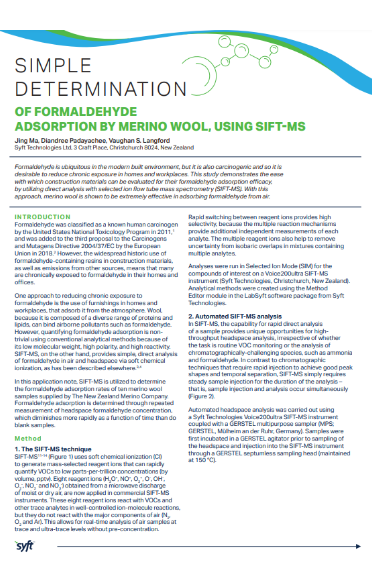
Simple Determination of Formaldehyde Adsorption by Merino Wool Using SIFT-MS
This study demonstrates the ease with which construction materials can be evaluated for their formaldehyde adsorption efficacy, by utilizing direct analysis with selected ion flow tube mass spectrometry (SIFT-MS). With this approach, merino wool is shown to be extremely effective in adsorbing formaldehyde from air.
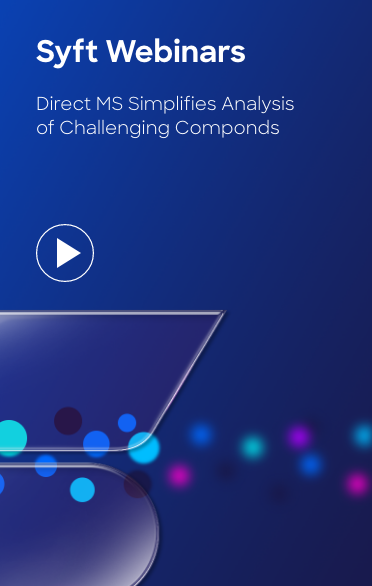
Direct MS Simplifies Analysis of Challenging Compounds
This webcast focuses on case studies that demonstrate simple analysis of chromatographically challenging compounds. Formaldehyde receives special attention, as it is important across a wide range of industries (from environmental to pharmaceutical testing).
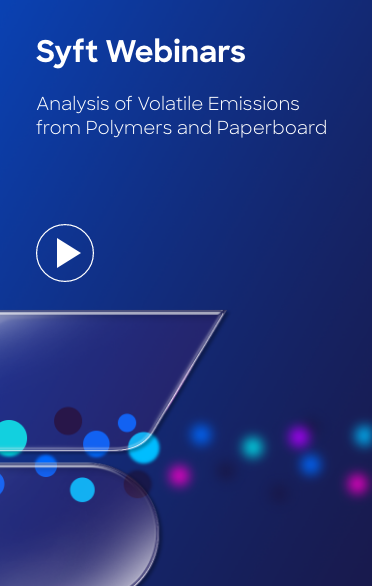
Analysis of Volatile Emissions from Polymers and Paperboard
This webinar describes a recent addition to the portfolio of techniques available for routine sample analysis: SIFT-MS. SIFT-MS enables rapid, quantitative analysis of VOCs across the full spectrum of packaging materials. Detailed case studies will describe applications in polymeric and paperboard emissions analysis.
SIFT-MS Selected Ion Flow Tube Mass Spectrometry
Learn about direct mass spectrometry by SIFT-MS which provides real-time, quantitative analysis of volatile compounds with trace-level sensitivity. There are also no requirements of chromatography, pre-concentration, or sample prep! SIFT-MS is easy to use and interpret data.
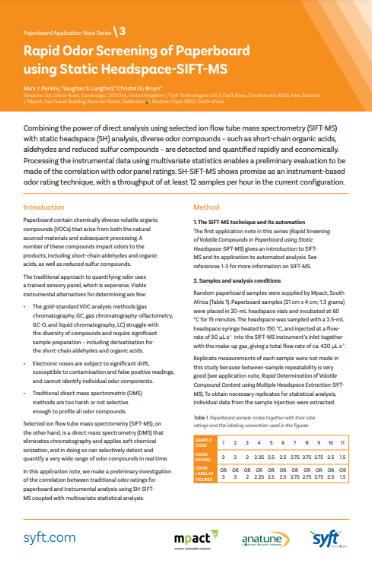
Paperboard Volatiles 3 - Odor Rating
SH-SIFT-MS provides an instrument-based odor rating technique for the analysis of diverse odor compounds – such as short-chain organic acids, aldehydes and reduced sulfur compounds. Throughput of at least 12 samples per hour can be achieved using this method.
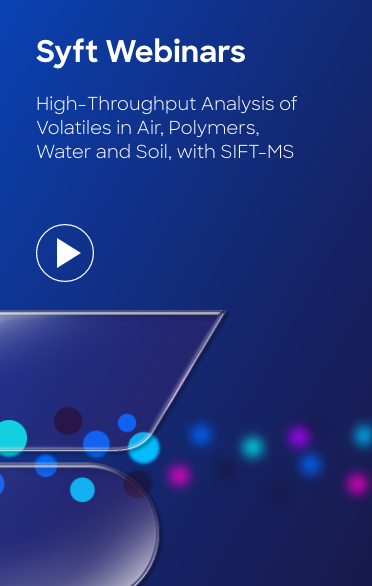
High-Throughput Analysis of Volatiles in Air, Polymers, Water and Soil, with SIFT-MS
In this webinar, we demonstrate the advantages of using automated SIFT-MS to analyze volatiles in diverse matrices: from air samples to the headspace of polymers, soil and water samples. Formaldehyde and the BTEX compounds (benzene, toluene, ethylbenzene and the xylenes) will be utilized in various case studies. In addition, high-throughput thermal desorption-SIFT-MS and real-time thermal extraction-SIFT-MS are presented for the first time.
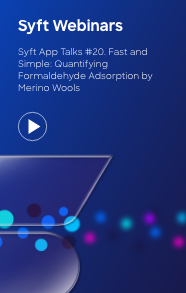
Syft App Talks #20. Fast and Simple: Quantifying Formaldehyde Adsorption by Merino Wools
This Syft App Talk describes how the SIFT-MS technique makes determination of formaldehyde adsorption by materials, such as wool, rapid and simple.
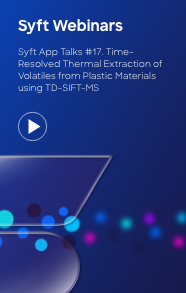
Syft App Talks #17. Time-Resolved Thermal Extraction of Volatiles from Plastic Materials using TD-SIFT-MS
In this presentation, examples of real-time thermal extraction and analysis of various plastic materials using TD-SIFT-MS are demonstrated, and its application to product development and processing environments are discussed. Direct, continuous analysis of formaldehyde from polyoxymethylene (POM) is of particular significance.

The SIFT-MS Automation Series: Episode 6 SIFT-MS Automation Past, Present and Future
In this sixth and final episode, Dr Perkins reflects on the automation journey and shares his practical "hot tips" for a wide variety of automated analyses. The webinar (and series!) concludes with a discussion of how automated SIFT-MS is an excellent complementary technique to the conventional laboratory "workhorse" techniques: gas and liquid chromatography.

The SIFT-MS Automation Series: Episode 5 Continuous Headspace Analysis… and Beyond and R&D laboratories.
In this fifth episode, Dr Perkins describes the novel continuous headspace analysis (CHA) technique that he developed to measure stripping of volatiles. (Note: CHA is not to be confused with dynamic headspace analysis!). In addition, Mark describes simple, very high-throughput gas sample bag analysis and touches on other recent developments – including thermal desorption-SIFT-MS.

The SIFT-MS Automation Series: Episode 4 Calibration Approaches for Automated SIFT-MS
In this fourth episode, Dr Perkins describes how simply and rapidly traditional instrument calibration is achieved with the automated SIFT-MS configuration. Traditional calibration approaches have not featured regularly in the SIFT-MS literature due to the widespread use of reliable library-based quantitation. However, calibration is essential for contract testing laboratories, so it is addressed in detail and from a number of different angles in this webinar.
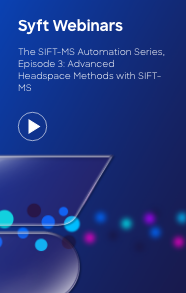
The SIFT-MS Automation Series, Episode 3: Advanced Headspace Methods with SIFT-MS
In this third episode, Dr Perkins describes the application of SIFT-MS to multiple headspace extraction (MHE). You will learn how to determine matrix-independent concentrations from MHE. Furthermore, Dr Perkins describes how the speed of SIFT-MS analysis can be leveraged to accelerate method development for both SIFT-MS and conventional methods – for example, through rapid determination of headspace equilibration times.
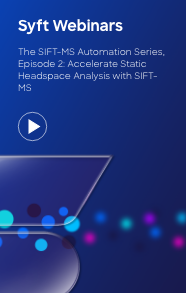
The SIFT-MS Automation Series, Episode 2: Accelerate Static Headspace Analysis with SIFT-MS
In this second episode, Dr Perkins provides a practical guide to automated static headspace (SH) analysis with SIFT-MS. You will learn how SH-SIFT-MS can address throughput challenges and simplify analysis of chromatographically challenging species.
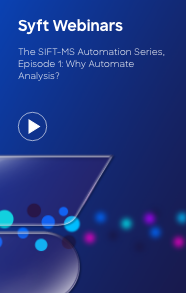
The SIFT-MS Automation Series, Episode 1: Why Automate Analysis?
In this first episode, Dr Perkins answers the important question:
Why Automate Analysis?
This webinar introduces the benefits of automation and discusses how they can be applied to SIFT-MS, enabling straightforward adoption by the contract laboratory.
SIMPLE, RAPID ANALYSIS OF PACKAGING FOR VOLATILE MOSH AND MOAH CONTAMINANTS
Headspace-SIFT-MS can screen over 220 samples per day for volatile MOSH and MOAH compounds – nearly seven-fold more samples than the routine liquid and gas chromatography method.
A Sensory Expert Shares His Experience with SIFT-MS
We asked Mike McGinley, President, St. Croix Sensory, Inc. about his experience using SIFT-MS. Hear what he had to say about the speed of analysis and flexibility inherent to Syft's product solutions.
High-Throughput, Quantitative Analysis of Benzene in Personal Care Products using Headspace-SIFT-MS
SIFT-MS provides rapid, sensitive, and robust analysis of benzene and other contaminants in a wide array of commercial products. Integration with a headspace autosampler enables rapid screening of hundreds of samples per day.
A Consumer Safety Expert Shares His Experience with SIFT-MS
We asked David Light, CEO and Founder of Valisure, about his experience using SIFT-MS and how it impacted their dry shampoo safety study.
High Throughput Screening of Recycled HDPE Pellets Using Untargeted Headspace-SIFT-MS-Analysis
Automated headspace-SIFT-MS analysis can classify pelleted recycled HDPE at throughputs over 230 samples per day, offering great potential for rapid screening of recycled packaging materials.
Rapid Screening of Paperboard For Volatile Leachables Using Static Headspace-SIFT-MS
Automated SIFT-MS analysis rapidly screens paperboard packaging for a wide range of functional groups in a single analysis, assuring that the volatile emissions meet manufacturer specifications. This application note describes a Headspace-SIFT-MS method with throughput >10X faster than traditional GC/MS methods.
High-Throughput Quantitative Analysis of Residual Monomer by Using MHE-SIFT-MS to Calibrate Single Headspace Injections
MHE-SIFT-MS provides rapid, matrix-independent, quantitative determination of volatile leachables in polymers and calibrates quantitative analysis based on single headspace injections. This approach enables over 200 samples per day to be analyzed, delivering rapid and economic analysis of volatile leachables such as residual monomers.
Syft Tracer: The Next Generation of Volatile Impurities Analysis for Enhanced Workflows
This app note introduces the next generation of SIFT-MS, Syft TracerTM, which launched at Pittcon 2023. It revolutionizes volatile impurities analysis workflows through unparalleled speed, performance stability, and reproducibility. Learn about how this innovation to real-time trace gas detection outpaces chromatography-based methods in the analysis of challenging analytes such as formaldehyde in a PEG excipient.
SIFT-MS: Quantifying the Volatiles You Smell . . . and the Toxics You Don’t
SIFT-MS has been widely applied to quantitative analysis of a broad range of VOCs in applications from food products to workplace safety to environmental monitoring, and most recently to pharmaceutical testing. This review surveys the applications of SIFT-MS in odor analysis and in workplace, environmental and consumer protection, with a particular focus on the complementarity of this real-time mass spectrometry analyzer to sensor technology and conventional laboratory techniques—in particular, gas chromatography–mass spectrometry (GC/MS).
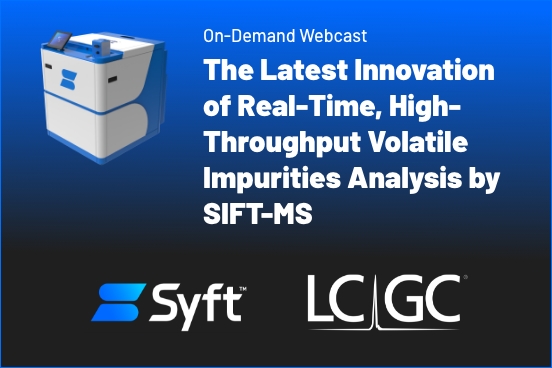
The Latest Innovation of Real-Time, High-Throughput Volatile Impurities Analysis by SIFT-MS
Join us for this webinar to learn about Syft Tracer, the latest advancement of real-time, trace gas analysis by SIFT-MS which launched at Pittcon 2023. Hear how the recent product innovations unlock analytical bottlenecks and enable faster decisions to be made in critical process steps.
Application Brief: Revolutionary Workflows for Volatile Impurities Analysis
This application brief summarizes a scenario relevant to contract research organization (CRO) and contract drug manufacturing organization (CDMO) laboratories where multiple volatile impurity methods need to be conducted in short runs. Five analyses are considered that can be handled by one Syft Tracer but require multiple legacy, chromatography instruments. For these analyses, SIFT-MS reports the first quantitative results 2- to 12-fold faster, and has sample throughputs 3- to 17-fold higher than the conventional procedures.
Wastewater Odor Analysis by SIFT-MS
In this application note, the performance of SIFT-MS is evaluated for analysis of odors from diverse sources at a modern wastewater treatment plant (WWTP). SIFT-MS provides comprehensive, quantitative profiling of odor sources and can identify operational abnormalities. In particular, the results presented demonstrate that methyl mercaptan is almost always a more significant odorant at this WWTP than hydrogen sulfide and confirm that the relative abundances of these odorants vary significantly.
Headspace-SIFT-MS: Flexibility that Revolutionizes Workflows for Diverse Samples
The characteristic flexibility, stability, high throughput, and fast time to data of the Syft Tracer next-gen SIFT-MS instrument apply across multiple headspace approaches for diverse matrices. This application note briefly summarizes the use of (1) dissolution, (2) multiple headspace extraction (MHE), and (3) the method of standard additions, then provides a guide for identifying the appropriate headspace approach for various matrices.
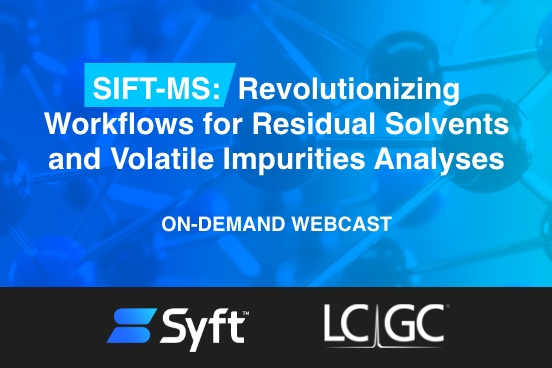
Revolutionizing Workflows for Residual Solvents and Volatile Impurities Analyses by SIFT-MS
This webinar demonstrates how the new, automated Syft TracerTM SIFT-MS platform provides a comprehensive solution to workflow challenges and can replace multiple chromatographic systems. Learn about how combining SIFT-MS with automation provides a very flexible and high throughput solution for screening volatile impurities in pharmaceutical and consumer safety applications, revolutionizing workflows.
Rapid Sensory Analysis of Paper Packaging Using SIFT-MS
This application note demonstrates that SIFT-MS effectively classifies paper samples by odor intensity rating and odor descriptor, in addition to distinguishing paper composition and mill of origin. When integrated with autosamplers, SIFT-MS provides throughputs of over 220 samples per day, supporting significantly enhanced quality assurance compared to conventional human sensory panels and gas chromatography-based analyses.
Revolutionizing Volatile Impurities Analysis Through Next Gen SIFT-MS
This E-book describes how next gen SIFT-MS enables rapid, continuous screening of toxic volatile impurities in pharmaceutical and consumer products. This advancement to SIFT-MS delivers trace-level detection sensitivity, unparalleled performance stability, superior selectivity, and highly reproducible, quantitative data. Never miss a contamination event again.
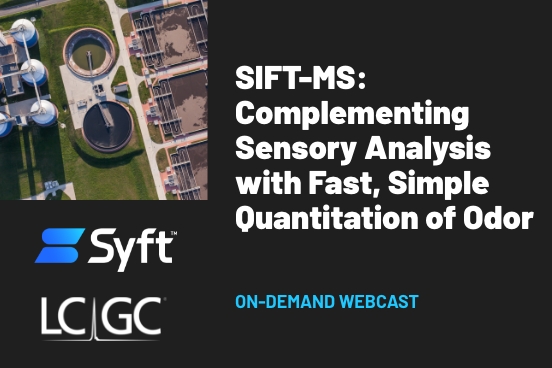
Fast, Simple Quantitation of Odors by SIFT-MS
In this on-demand webinar, Michael McGinley, President, St. Croix Sensory, describes how SIFT-MS has advanced their ability to rapidly perform odor analysis. A variety of SIFT-MS-based odor applications correlated with conventional sensory panel assessment are presented. Learn how Syft is Simply. Faster. for the analysis of odor compounds.
Improved MHE-SIFT-MS Workflows - Concentration Independent MHE Calibration
This application note investigates concentration dependence of MHE calibration in sample matrix. Across the full range of analytes investigated in this study, MHE calibration holds for at least one order of magnitude change in sample concentration. For analytes in the C7–C9 range, the MHE calibration applies over two orders of magnitude analyte concentration. These results mean that the MHE workflow can be applied to a wider range of samples in the matrix, further reducing calibration demand.
High-Throughput Screening of Polypropylene Polymer using Untargeted Headspace-SIFT-MS Analysis
This application note describes how SIFT-MS coupled with multivariate statistical analysis can be utilized for rapid screening of pelleted virgin and recycled polypropylene using an untargeted “fingerprinting” approach. Automated headspace-SIFT-MS analysis can classify and qualify polypropylene samples at throughputs of over 230 samples per day, offering great potential for rapid screening of recycled polypropylene feedstock for FCM applications. Adoption of SIFT-MS supports product quality and enhances sustainability.
Real-Time Monitoring of Volatile Organic Compounds in Ambient Air Using Direct Injection Mass Spectrometry
In this article, the results of a DIMS air monitoring campaign in Auckland, New Zealand, are described. Real-time SIFT–MS measurements were obtained at three sites over a period of several weeks each. At each site, SIFT–MS provided effective on-site analysis to sub-ppbV levels with better than 1-min time resolution.
High-Throughput Analysis of Polymers for Benzene and Volatile MOSH and MOAH Residues
This application note describes the utility of SIFT-MS in pre-screening polymer packaging materials for volatile MOSH and MOAH compounds. Automated SIFT-MS can characterize 12 high-density polyethylene (HDPE) and polypropylene (PP) samples per hour, or 220 / day. Headspace-SIFT-MS readily analyzes benzene at high sensitivity as part of the same analysis.
Real-Time Roadside SIFT-MS Monitoring: Unreported VOC Emissions from Road Transport
This application note summarizes key SIFT-MS results obtained and conclusions made in a peer reviewed open-access article entitled “Unreported VOC Emissions from Road Transport Including from Electric Vehicles.” Learn how the Wolfson Atmospheric Chemistry Laboratory at the University of York used SIFT-MS for VOC analysis in its platform to experimentally verify – for the first time – that motor vehicle screen wash is a significant unreported source of VOC emissions (especially for ethanol and methanol).
Analysis of Volatile Residues in Polymers by SIFT-MS
This application note reviews polymer analysis applications of automated headspace-SIFT-MS. Rapid quality assurance/quality control (QA/QC) screening of over 220 samples/day can be conducted using targeted or untargeted analysis, while quantitative volatile impurity analysis is achieved efficiently using multiple headspace extraction (MHE)-SIFT-MS.
SIFT-MS Analysis of Benzene in Sunscreens and VOC Exposure
This application note summarizes the SIFT-MS results obtained in a study of exposure to VOCs from 26 retail sunscreen products – both VOCs intended as ingredients and those present as contaminants. The commercial products varied widely in VOC content and hence user exposure. Several products contained benzene contamination that was readily quantified using dynamic headspace-SIFT-MS analysis.
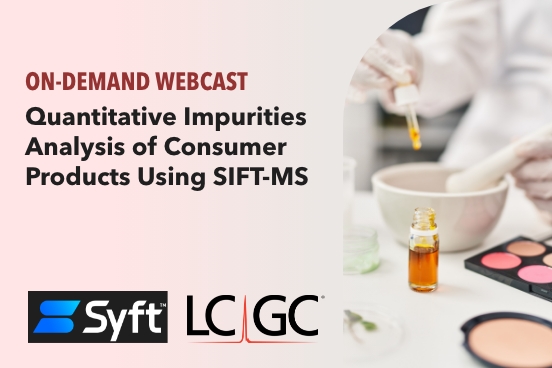
Quantitative Impurities Analysis of Consumer Products Using SIFT-MS
This webinar features David Light of Valisure and includes case studies that demonstrate how SIFT-MS provides faster and more accurate analysis of volatile impurities in consumer products. Learn how benzene has been detected in commercial products like dry shampoo and sunscreens.
High Throughput SIFT-MS Quantitative Analysis: Beer Analysis Using the Method of Standard Additions
Read the application note, "High Throughput SIFT-MS Quantitative Analysis of Beer Using the Method of Standard Additions," to learn how automated headspace-SIFT-MS quantitatively analyzes VOCs in beer with throughput of 12 samples / hr and time to first result that is >2X faster than chromatographic methods.
VOC Pollution Monitoring in South Korea
This publication reviews VOC pollutant monitoring applications of SIFT-MS in South Korea. SIFT-MS has been applied to emission source characterization, fenceline monitoring, ambient monitoring, pollution mapping, and incident response (including the use of drone-based sampling) for hazardous air pollutants (HAPs), odor nuisance species, and compounds that have high ozone formation potential (OFP) and/or contribute to secondary aerosol (SOA) formation.
Quantification of Ethylene Oxide Contamination in the Presence of Acetaldehyde
A rapid analysis method is needed to ensure food safety by high-throughput screening for ethylene oxide contamination. SIFT-MS is a suitable method for rapid quantification of trace amounts of EtO vapors in the headspace of food samples. This study shows experimental data that reveals how the OH− reagent ion is suitable for overcoming product ion overlap and interferences observed with other reagent ions in this analysis.
Syft Contributes Real-Time VOC Data to Aeroparts VOC Ozone Converter Bleed Air Study
This video describes the bleed air study led by AeroParts in Oct 2023 to understand the differences in VOC ozone converter performance. VOC ozone converters have the potential for preventing airplane cabin smoke odor fume events. Learn how SIFT-MS enabled this important study by providing real-time VOC analysis of simulated engine bleed air.
Real-Time Analysis of Volatile PFAS Compounds in Ambient Air
This presentation from Dr. Leslie Silva at Pittcon 2024 describes preliminary work that demonstrates the ability of SIFT-MS to analyze volatile PFAS compounds in real-time. The use of negative reagent ions gives SIFT-MS a distinct selectivity advantage over competing technologies and legacy chromatographic methods.
What's in Your Air? Protecting the Environment and People with SIFT-MS
In this presentation from Analytica 2024, Marino Beenhakker and Dr. David Muller describe environmental and consumer product applications of next-gen SIFT-MS including ambient air monitoring in New Zealand and PFAS measurement in consumer goods.